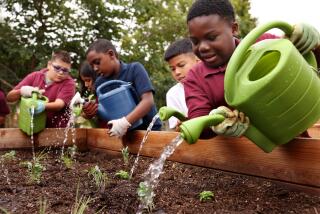FOR THE KIDS RECYCLING : Trash Treasure : Some students at an Oxnard school spend the summer developing a system to save paper, plastic foam and aluminum.
- Share via
If you think all of the teen-agers in Oxnard are surfing or lying on the beach this summer, guess again.
Many of them are hard at work, trying to start a recycling program at Richard B. Haydock Intermediate School. Students are recruiting teachers and volunteers to develop a system to save paper, plastic foam and aluminum.
“We learned that as children, we can make a difference as long as we care,” said Dung Hoang, 13, an eighth-grader at Haydock.
Dung was one of more than 100 teen-agers who attended a three-day leadership conference for Gifted and Talented Education students at Westmont College in Santa Barbara between May 30 and June 1. There she met other people who, like herself, noticed how students throw away test papers, essays and graded homework papers that can be recycled.
“A lot of students just looked at the grade and then threw it away,” Dung said. “It’s really a waste.”
To tackle the problem, Dung formed a committee of three eighth-graders--Marcello Isaac, Delilah Vinzon and Ruth Myers. They hope to recruit seventh-graders who can turn a good idea into a school tradition.
It was her social studies teacher, Harold Wasserman, who first inspired Dung to think about recycling. Since he started teaching at Haydock in 1989, Wasserman put two paper recycling boxes in his classroom: one for used white paper and one for colored paper, magazines and lunch bags.
Each class had been receiving free subscriptions to local newspapers, which most teachers threw away at the end of the day. Wasserman, however, stashed the old newspapers in a closet and then took them to a recycling center. He reminded the students that a six-foot stack of newspapers was equivalent to one 20-foot tree.
After the Westmont conference, Dung and her friends asked Wasserman and math instructor Marcia Quayle to sponsor them in their attempt to put a recycling box in each classroom and in the library. On the last day of class on May 24, students from six different classes lugged in enough paper to save 20 trees.
The goal is to first cut down on using paper, and then recycle what has been used, said Allison Maires, a “trashologist” for the Ventura Regional Sanitation District. About 30% of all garbage generated in Oxnard is paper, she said.
Wasserman, who urged students to use both sides of a piece of paper, set an example for the class by photocopying on both sides of a sheet and by encouraging students to do their homework on the back of previous assignments.
He also pointed out that waste can be cut down in the Haydock cafeteria, where at least 15 large garbage bags of foam trays are thrown away every day. About 9% of Oxnard’s trash is plastic foam, Maires said, but a relatively small amount of foam takes up a large amount of space.
Dung and her friends are now looking into the possibility of cooperating with Ralphs Grocery Co., which provides a free service of trucking plastic foam products to Los Angeles for recycling. Students are also researching the option of giving the foam to companies that will use the material to insulate mobile homes, trucks and campers.
The Haydock committee has asked the city of Oxnard to donate two recycling bins for the cafeteria, one for foam trays and the other for aluminum cans. Currently, students who wish to recycle their cans place them by the cafeteria window for the janitor to pick up. The cans are given to special education students, who squash them flat for the recycling center. The money they receive is put into a fund to help pay for a special education summer camp.
Dung’s committee also plans to remind fellow students to use lunch boxes instead of brown paper bags or to use one brown bag several times before throwing it away. They will also push for the use of thermos bottles instead of juice boxes, which cannot be recycled.
“We want parents to be our role models,” Dung said. “They can spread the word to their kids and start conserving at home. Kids learn from example, just like I did from Mr. Wasserman. He recycled everything.”
Like many of the teachers at Haydock, Maires is delighted at the students’ initiative.
“Kids end up as terrific soldiers in this battle,” Maires said. “They’re the ones who end up motivating and reminding the adults.”
More to Read
Sign up for Essential California
The most important California stories and recommendations in your inbox every morning.
You may occasionally receive promotional content from the Los Angeles Times.










